The information shared in this post is for informational purposes only and should not be considered as a replacement for professional medical advice. The statements made on this article regarding CBD have not been evaluated by the Food and Drug Administration. The efficacy of CBD has not been confirmed by FDA-approved research. CBD is not intended to diagnose, treat, cure or prevent any disease. Consult your doctor before using CBD, especially if you have any medical conditions. Your doctor can help determine if CBD is right for you.
The endocannabinoid system (ECS) is a term that comes up a lot in the hemp industry. It’s said to be one of the most important physiological systems that exists, but what exactly is it?
At the most basic level, the ECS can be thought of as a system in the human body that ensures you stay healthy and balanced.
Its primary role is to maintain homeostasis in the body and mind. This complex network of receptors, naturally occurring endocannabinoids, and enzymes regulate functions like sleep, mood, appetite, pain perception, immune response, digestive function, and more.
In this comprehensive guide, you’ll learn everything you need to know about the ECS, including what it is, how it works, and how hemp plant compounds can support how the endocannabinoid system functions.
What You Will Discover
- The endocannabinoid system (ECS) is a complex physiological system in the human body that regulates things like mood, sleep, pain regulation, immunity, digestive health, and more. The primary role of the ECS is maintaining homeostasis (balance) in the body and mind.
- The ECS is comprised of cannabinoid receptors, endocannabinoids that are naturally produced in the body, and enzymes. The ECS is like a chemical messenger system with receptors distributed throughout the body that correlate with their varied functions in the nervous and immune systems.
- It’s suggested that supporting the ECS with cannabis plant cannabinoids like THC and CBD offers benefits to improve ECS function and provide potential therapeutic results.
Exploring the Endocannabinoid System (ECS)
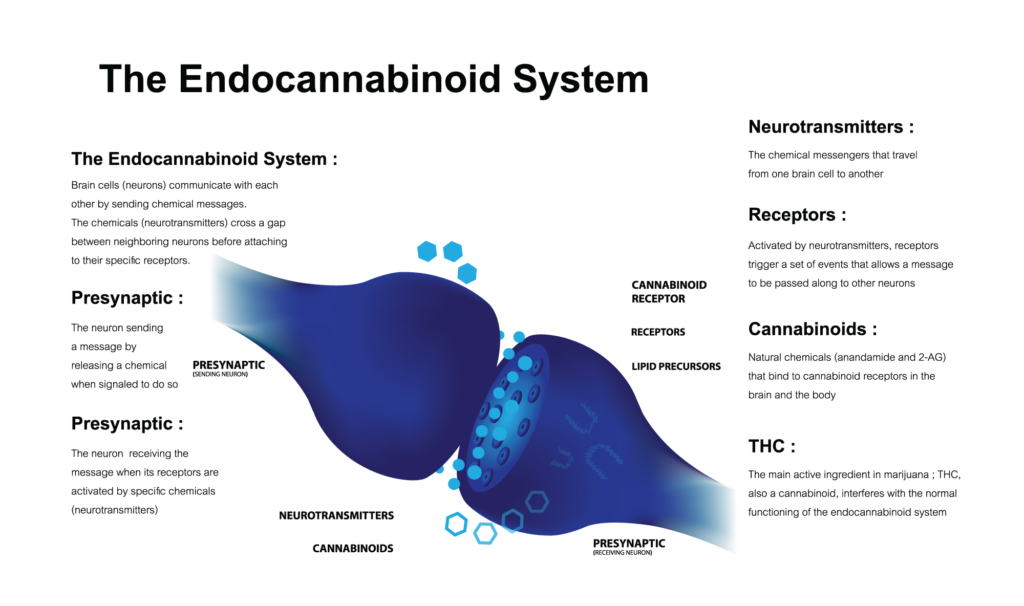 The endocannabinoid system (ECS), also known as the endogenous cannabinoid system, has been dubbed “one of the most important physiological systems involved in establishing and maintaining human health.” [1]
The endocannabinoid system (ECS), also known as the endogenous cannabinoid system, has been dubbed “one of the most important physiological systems involved in establishing and maintaining human health.” [1]
What makes the ECS so important, though?
It’s simple. The primary role of the ECS is to ensure that numerous functions in the body stay balanced so you stay healthy. It’s responsible for what’s known as homeostasis, or maintaining a stable internal environment despite any external changes.
At the most basic level, the ECS contains two endocannabinoids, two cannabinoid receptors, and two enzymes. They work together to influence a huge range of functions, including appetite, mood, sleep, stress response, digestion, immune function, and more.
Endocannabinoids produced by the body (“endo” means within) are very similar to phytocannabinoids or cannabinoids produced by the cannabis plant (“phyto” means plant).
The Discovery of the ECS
The story of the ECS begins with the discovery of THC, the primary psychoactive element of cannabis, in 1964 by Raphael Mechoulam and Yechiel Gaoni in Israel.[2] Unveiling the endocannabinoid system was a groundbreaking discovery that steered researchers down a new path.
1998 marked a significant moment in scientific history, it was Mechoulam and Gaoni’s pioneering work that led to the formal recognition of the ECS and set the stage for our current understanding of how the ECS impacts human health.
The first cannabinoid receptor (CB1) was discovered in 1988 and the first endocannabinoid (anandamide, or AEA) in 1992. The second cannabinoid receptor (CB2) in 1993, and the second endocannabinoid (2-Arachidonoylglycerol, or 2-AG) in 1995.[3] In 1997, the two enzymes that complete the ECS were discovered: fatty acid amide hydrolase, or FAAH, and monoacylglycerol lipase, or MAGL.
The discovery of the ECS shed light on the mechanism behind how cannabis impacts humans and how phytocannabinoids like THC amplify the activation of the cannabinoid receptor CB1.
The discovery of the ECS was a breakthrough in our understanding of why cannabis has the effects it does on humans. Phytocannabinoids found in cannabis, as it turns out, are almost identical to endocannabinoids found in humans.
Homeostasis is the Main Function of the ECS
The main function of the ECS is to maintain homeostasis throughout the body. Cannabinoid receptors found throughout the body and mind work with endocannabinoids and ECS enzymes to keep the body’s internal environment balanced and healthy.
CB1 receptors are found primarily in the central nervous system (CNS), while the majority of CB2 receptors are concentrated in immune cells and the spleen.
CB1 and CB2 receptors interact with the body’s naturally occurring endocannabinoids in a process known as endocannabinoid signaling. The signals are communication between cells that regulate various functions and maintain homeostasis.
Cannabinoids, due to their structural similarity to endocannabinoids, can interact with and influence the CB1 and CB2 receptors in the endocannabinoid system. Their direct and indirect influence on CB1 and CB2 receptors can help maintain homeostasis when endocannabinoid function becomes imbalanced or dysregulated.
Understanding the Architectural Framework of the ECS
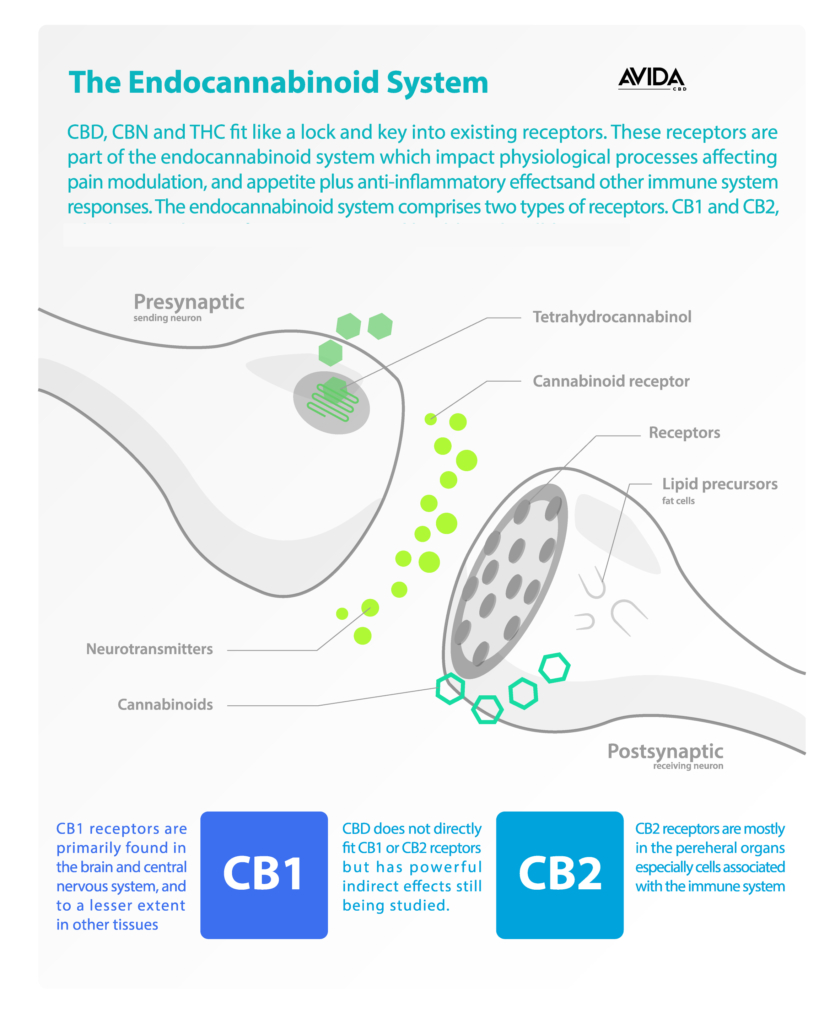 Understanding the architectural framework of the ECS (aka what it’s made of) can offer a better understanding of how it works.
Understanding the architectural framework of the ECS (aka what it’s made of) can offer a better understanding of how it works.
This extremely complex system is made of three primary parts that work together to keep the body in balance: Cannabinoid receptors, Endocannabinoids, and Enzymes.
Cannabinoid Receptors
CB1 and CB2 receptors are found throughout the body, playing distinct roles depending on their location. They’re activated by endocannabinoids and cannabinoids from external sources, such as those found in the hemp plant. CB1 and CB2 receptors function as part of the G protein-coupled receptor family responsible for transmitting signals from a cell’s exterior to its interior.
Their distribution within the body directly influences their unique functions.
CB1 receptors are primarily found in the central nervous system. A large concentration is found in the brain in areas like the cerebellum, basal ganglia, and hippocampus. They’re responsible for mediating the psychoactive effects of THC and influence things like appetite, emotional response, memory, mood, pain regulation, and motor control.
CB2 receptors are located in large concentrations throughout immune cells, ultimately playing an integral role in the body’s immune responses. They are closely associated with regulating inflammatory responses and neuropathic pain.[4]
Endocannabinoids
The two main endocannabinoids, or endogenous cannabinoids, include anandamide (AEA) and 2-Arachidonoylglycerol (2-AG). They serve as chemical messengers that work with cannabinoid receptors to influence different functions and support homeostasis.
AEA is largely associated with mood regulation and feelings of pleasure. Some studies suggest it may have potential antidepressant-like effects, which could contribute to its potential anxiolytic effects. Additionally, it may also play a role in the euphoria associated with cannabis and other drug use.[5]
2-AG is the most abundant endocannabinoid, serving several functions throughout the body. It’s associated with pain perception, neuroprotection, cognition, energy, and more.
Enzymes
ECS enzymes include fatty acid amide hydrolase (FAAH) and monoacylglycerol lipase (MAGL).
They’re mainly responsible for the degradation of endocannabinoids after they’ve been used by the body, but they also play a small part in endocannabinoid synthesis.
How Endocannabinoid Signaling Works
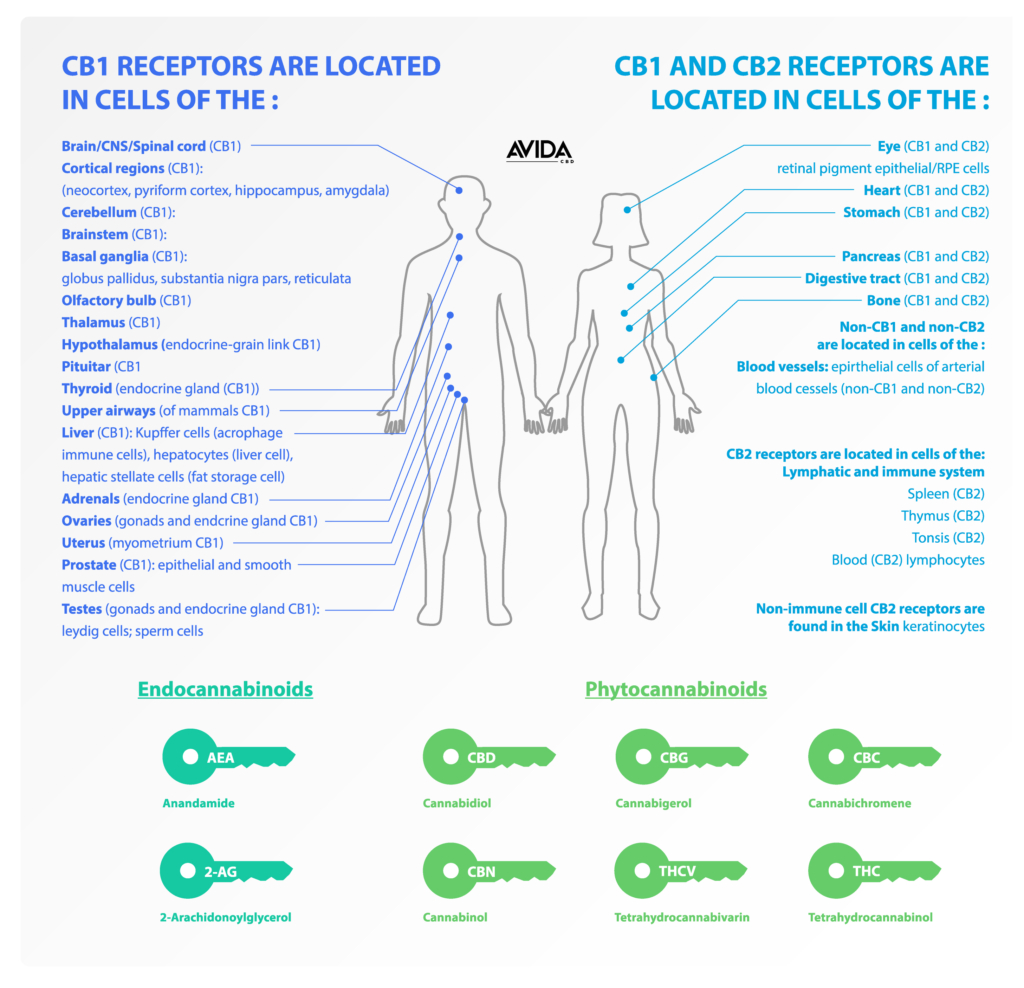 Endocannabinoid signaling is an intricate process that helps maintain ideal endocannabinoid levels while regulating various physiological functions. When endocannabinoids bind to cannabinoid receptors it triggers the activation of G protein-coupled receptors which triggers various cellular responses.
Endocannabinoid signaling is an intricate process that helps maintain ideal endocannabinoid levels while regulating various physiological functions. When endocannabinoids bind to cannabinoid receptors it triggers the activation of G protein-coupled receptors which triggers various cellular responses.
Activation of cannabinoid receptors can lead to the inhibition of neurotransmitter release and other chemicals, ultimately benefiting functions such as pain regulation, mood modulation, and immune response, which are influenced by the ECS.
Deeper insights into cannabinoid receptor activation and cannabinoid receptor signaling processes can offer a better understanding of how this complex system works.
Endocannabinoid synthesis and degradation by ECS enzymes is also a major part of ECS function. Endocannabinoids like AEA and 2-AG are produced and broken down by these enzymes once they’ve served their purpose.
AEA is synthesized mainly from N-arachidonoyl phosphatidylethanolamine and degraded mainly by FAAH. 2-AG is produced from diacylglycerol by diacylglycerol lipases (DAGL) and is primarily degraded by MAGL.
The ECS and Its Therapeutic Targets
The therapeutic potential of the ECS is linked to its function in various bodily processes. By targeting specific receptors with cannabinoids, there’s a possibility of achieving therapeutic benefits for different health conditions and diseases.
The ECS is widely recognized for its potential influence on things like stress, anxiety, depression, and pain. By targeting CB1 and CB2 receptors with cannabinoids, ongoing research is examining their link and potential in easing or managing these conditions.
There’s a growing interest in the ECS as a target for a wide range of health conditions. The potential of supporting ECS function with cannabinoids like CBD and others offers promise for the effectiveness of cannabinoid-based drugs and products.
Potential Support to Manage Pain and Inflammation
The ECS plays a crucial role in pain and inflammation management by modulating the release of neurotransmitters.
CB1 and CB2 cannabinoid receptors modulate pain perception, suggesting their potential to reduce pain. Activating the CB1 receptor, for example, is shown to induce analgesic effects. CB2 receptor activation may provide pain relief due to its role in providing anti-inflammatory effects.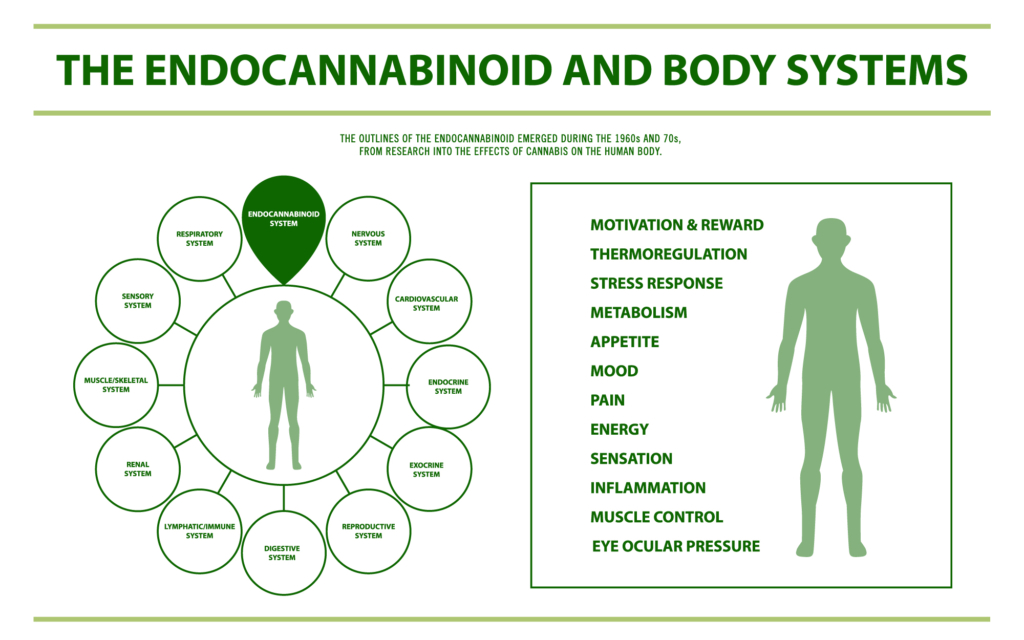
The potential analgesic properties of THC and other cannabinoids may be enhanced by other cannabis compounds in a synergistic interaction known as the entourage effect. This widely accepted theory suggests cannabis compounds work better together than their isolated counterparts.[6]
Promising Neuroprotective Properties
The ECS plays a huge role in neuroprotection, making it a potential target for improving learning and memory function. Activation of CB1 receptors has been linked to cognitive support, showing promise in addressing cognitive decline associated with aging and neurodegenerative diseases.
Supporting the ECS can open up new possibilities for therapies, including using cannabis and hemp, that may enhance neuroprotection and cognitive function.
Cannabinoids are being researched for their neuroprotective and antioxidant properties and their potential to support neuroplasticity and influence synaptic transmissions.[7] This means there is a possibility cannabinoids could help the brain change and adapt and affect how brain cells talk to each other.
While research suggests that ECS activity declines with aging, supporting ECS function with cannabinoids like THC and CBD may contain the potential to restore cognitive functions. More studies are needed to fully understand how THC, CBD, and other cannabinoids can affect cognitive functions, especially in the context of aging.
The Influence of External Cannabinoids on the ECS
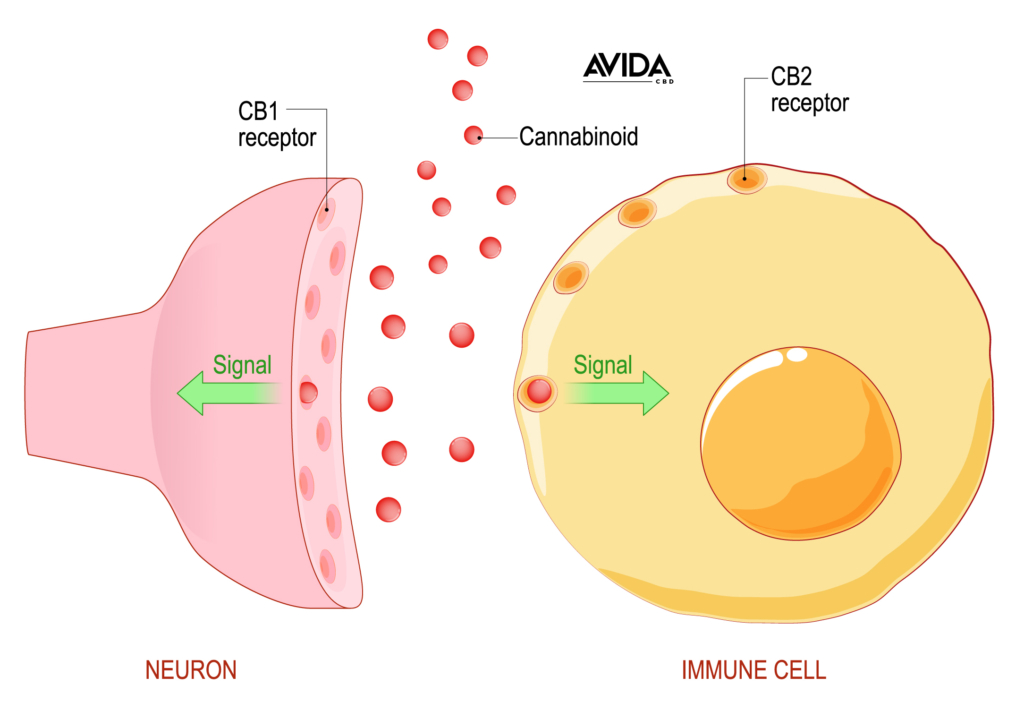 When the body’s endocannabinoid signaling is disrupted, external cannabinoids, like CBD and THC, can be introduced, which may affect several ECS physiological processes.
When the body’s endocannabinoid signaling is disrupted, external cannabinoids, like CBD and THC, can be introduced, which may affect several ECS physiological processes.
THC, the main psychoactive cannabinoid found in cannabis, binds to both CB1 and CB2 receptors, leading to various effects on the body and mind. CBD, on the other hand, does not bind to either receptor, instead exerting an indirect influence on the cannabinoid receptors but still supporting ECS function in other ways.
The interaction of various cannabinoids may produce a wide range of effects, and ongoing research is being done to understand their effect on pain relief, appetite stimulation, stress relief, and more.
A Deeper Look at THC’s Influence on the ECS
THC can activate both CB1 and CB2 receptors, resulting in various effects on the human body. THC’s binding affinity to CB1 receptors is largely associated with the cannabinoids’ intoxicating and psychoactive effects, which influence memory and motor control.
Research is exploring THC’s interaction with CB1 and CB2 receptors and how they may lead to pain relief by modulating the release of neurotransmitters and neuropeptides, which influence functions in pain signaling.
Additionally, there is ongoing research into THC’s influence on CB1 receptors, which includes studies on how THC might induce side effects like anxiety and paranoia in some users.
CBD’s Indirect Influence on the ECS
CBD, unlike THC, doesn’t cause intoxication, primarily because it doesn’t directly bind to CB1 receptors. In fact, it doesn’t bind to either of the main cannabinoid receptors. Instead, CBD influences these receptors indirectly.
CBD is what’s known as a negative allosteric modulator of the CB1 receptor, meaning CBD can modify the receptors’ shape. Ultimately, this blocks the CB1 receptors’ ability to bind with other molecules, such as THC. This is why CBD may reduce some of the adverse effects of THC when taken together.
Additionally, CBD also influences ECS function by interacting with other brain signaling systems. It increases cannabinoid signaling by increasing AEA levels and inhibiting FAAH activity. It’s also a 5HT1A serotonin receptor agonist, which is being studied for its potential stress-relieving effects.[8]
The Future of Endocannabinoid Research
The future of endocannabinoid research is promising. Increased research into ECS function has led to promising new developments looking to activate CB1 and CB2 receptors with the use of cannabinoids.
Pain management, inflammatory and neuropathic pain, mood disorders, sleep issues, and more are all potential targets of the ECS that are still being explored.
That said, an increased understanding of the ECS has led to increased research on how cannabis plant compounds can regulate endocannabinoid signaling and offer potential therapeutic relief.
Research also led to a deeper understanding of how cannabis works in the body and its impact on human cannabinoid receptors, influencing an increased push for recreational and medical marijuana legalization.
The development of potent products that can selectively activate the receptors to produce a biological response is necessary to be able to activate specific endocannabinoid receptors and achieve desired effects. While more research is necessary to fully understand the ECS, the future of ECS research looks bright.
With several pre-clinal studies that highlight the promise of cannabis to support ECS function, an increase in clinical studies is essential to better understand its therapeutic potential.
Summary
The endocannabinoid system is believed to play a significant role in maintaining both mental and physical health. It’s thought to be crucial in maintaining homeostasis, which is the body’s way of keeping internal balance across various functions.
The ECS’s involvement in processes like pain sensation, inflammation, and nerve function suggests its potential therapeutic value. However, it’s important to note that these areas are still under active research.
Ongoing studies into how cannabinoids like THC and CBD interact with the ECS are enhancing our understanding of their effects on the body and mind. These studies focus on how these substances influence the ECS’s CB1 and CB2 receptors.
As research continues, we’re gaining more insights into the ECS’s complexities and the potential of cannabis-related compounds to interact with this system. However, it’s crucial to remember that this field is evolving, and more research is needed to fully understand these interactions and their implications.
Frequently Asked Questions
What is the endocannabinoid system and what is its role?
The Endocannabinoid System (ECS) is a complex and important regulatory network within the body. Its primary function is to maintain homeostasis, ensuring a stable internal environment. The ECS plays an important role in regulating processes like pain perception, stress response, appetite regulation, memory formation, and immune system activity. This system, through its complex interactions with endocannabinoids and receptors, is crucial for balancing these various functions.
What do cannabinoids do to the body?
Cannabinoids interact with specific receptors in the body, known as cannabinoid receptors, to influence various processes such as pain sensation, mood regulation, appetite, memory, and immune response. These interactions help support the overall function of the ECS, which is essential for maintaining the body’s internal balance and stability.
How do you activate the endocannabinoid system?
The endocannabinoid system can be activated in various ways, including the use of cannabis and hemp products, which contain cannabinoids that interact with the system. Also, lifestyle factors such as regular exercise, eating a balanced diet, and effectively managing stress are ways to naturally activate the endocannabinoid system’s function.
What roles do CB1 and CB2 receptors play in the body?
CB1 and CB2 receptors are influenced by both endocannabinoids found in the body and cannabinoids from cannabis and hemp. CB1 receptors are primarily involved in regulating things like memory, pain, and motor control, while CB2 receptors are more involved with immune system responses and overall function.
References
- Alger, B. E. (2013, December 1). Getting high on the endocannabinoid system. PubMed Central (PMC). https://www.ncbi.nlm.nih.gov/pmc/articles/PMC3997295/#:~:text=The%20endogenous%20cannabinoid%20system%E2%80%94named,%2C%20glands%2C%20and%20immune%20cells.
- Crocq, M. (2020). History of cannabis and the endocannabinoid system. Dialogues in Clinical Neuroscience, 22(3), 223–228. https://doi.org/10.31887/dcns.2020.22.3/mcrocq
- Mackie, K. (2008). Cannabinoid Receptors: Where They are and What They do. Journal of Neuroendocrinology, 20(s1), 10–14. https://doi.org/10.1111/j.1365-2826.2008.01671.x
- Turcotte, C., Blanchet, M. R., Laviolette, M., & Flamand, N. (2016). The CB2 receptor and its role as a regulator of inflammation. Cellular and Molecular Life Sciences, 73(23), 4449–4470. https://doi.org/10.1007/s00018-016-2300-4
- Gobbi, G., Bambico, F. R., Mangieri, R. A., Bortolato, M., Campolongo, P., Solinas, M., Cassano, T., Morgese, M. G., Debonnel, G., Duranti, A., Tontini, A., Tarzia, G., Mor, M., Trezza, V., Goldberg, S. R., Cuomo, V., & Piomelli, D. (2005). Antidepressant-like activity and modulation of brain monoaminergic transmission by blockade of anandamide hydrolysis. Proceedings of the National Academy of Sciences of the United States of America, 102(51), 18620–18625. https://doi.org/10.1073/pnas.0509591102
- Sofrás, F. M. S., & Desimone, M. F. (2023). Entourage Effect and Analytical Chemistry: Chromatography as a Tool in the Analysis of the Secondary Metabolism of Cannabis sativa L. Current Pharmaceutical Design, 29(6), 394–406. https://doi.org/10.2174/1381612829666221103093542
- Hampson, A. J. (1998, April 21). US6630507B1 – Cannabinoids as antioxidants and neuroprotectants – Google Patents. https://patents.google.com/patent/US6630507B1/en%E2%80%9D#:~:text=nonpsychoactive%20cannabidiol%20and%20psychoactive%20cannabinoids,preventing%20ROS%20toxicity%20in%20neurons.
- Henson, J. D., Vitetta, L., Quezada, M., & Hall, S. (2021). Enhancing Endocannabinoid Control of Stress with Cannabidiol. Journal of Clinical Medicine, 10(24), 5852. https://doi.org/10.3390/jcm10245852
